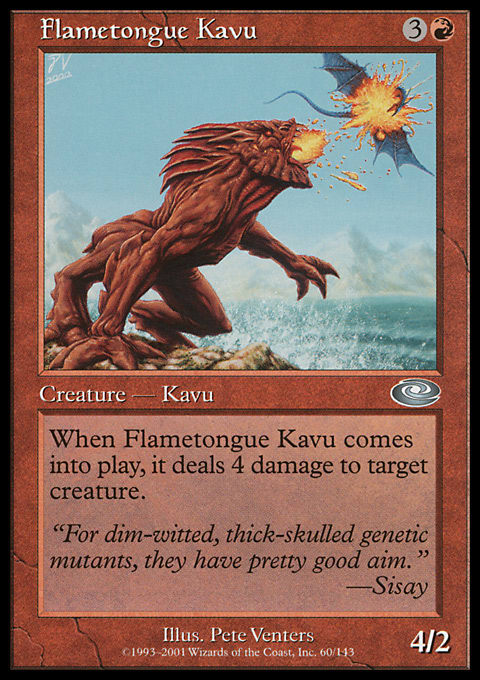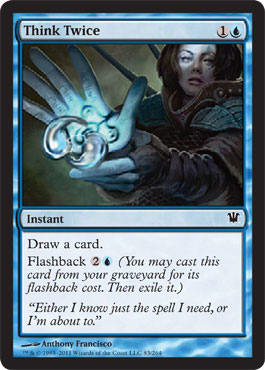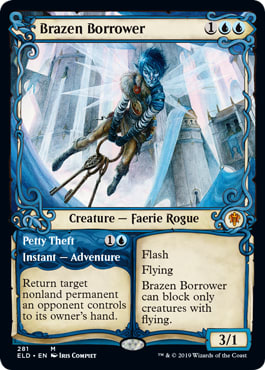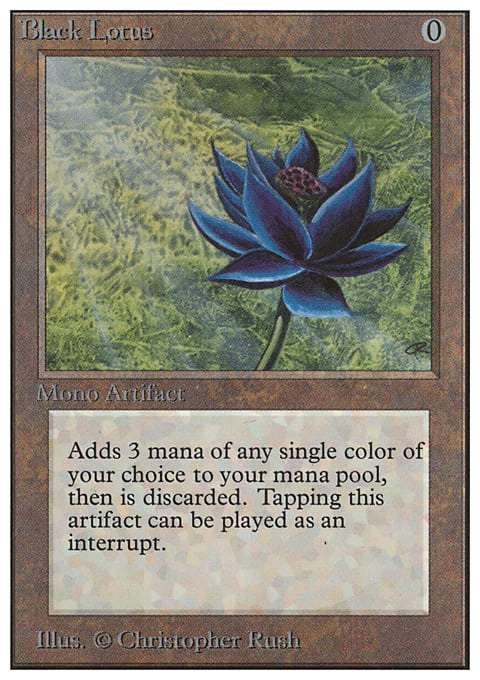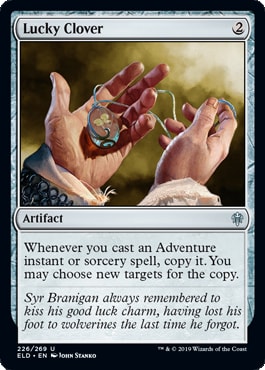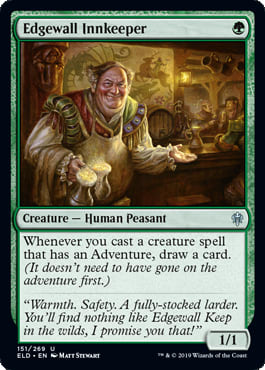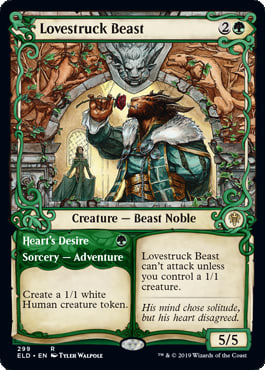If you've logged onto Magic: The Gathering Arena lately, you've probably started to hit a new opponent on the ladders... At least relative to the last month or so of mostly Azorius and Red Deck enemies. That deck is Temur Adventures and it can be very hard to beat.
While I was originally a little surprised to see this deck as more than 50% of my average Best-of-Three opposition, I quickly learned it had won the large DreamHack tournament a little while back, and has started to gain adherents among the game's best minds.
Here's the version from DreamHack:
Temur Adventures | THB Standard | littlebeep, 1st Place DreamHack
- Creatures (24)
- 4 Beanstalk Giant
- 4 Bonecrusher Giant
- 4 Brazen Borrower
- 4 Edgewall Innkeeper
- 4 Fae of Wishes
- 4 Lovestruck Beast
- Instants (1)
- 1 Incubation // Incongruity
- Sorceries (3)
- 3 Escape to the Wilds
- Artifacts (5)
- 1 The Great Henge
- 4 Lucky Clover
- Lands (27)
- 2 Mountain
- 4 Island
- 6 Forest
- 1 Temple of Epiphany
- 1 Temple of Mystery
- 2 Temple of Abandon
- 3 Steam Vents
- 4 Breeding Pool
- 4 Stomping Ground
1. Temur Adventures is Hard to Grind Out
Temur Adventures is exceptionally difficult to angle or outmaneuver using the traditional avenues of attrition, chip shots, or incremental card advantage. If you think about it, why becomes almost obvious.
Over the course of my Magic writing career I have no idea how many times I've written some version of "the two-for-one deck" archetype primer. Many Standard formats given enough time have space for this kind of card advantage deck; the aggro decks are slow enough to be beaten on the merits and the combo and control decks are not so over-the-top that good old fashioned card advantage still works on them. Temur Adventures is not an obvious rebirth of the two-for-one one creature deck... Because the Adventures mechanic itself is simply not obvious.
Contrast these two cards:
Bonecrusher Giant is a good deal better... But it's not immediately obvious why. The total cost on Bonecrusher Giant is higher and the sort of Red damage add-on is lower. But Bonecrusher Giant is a powerful Staple that's proudly played in Modern whereas Flametongue Kavu might have a hard time reestablishing itself in Standard.
Here's an easy card to understand:
You pay a reasonable cost to draw a card; then somewhere along the line you pay a less reasonable (but "free" add-on) three to draw another card. That's an easy and explicit two-for-one one... That you even get to make a down payment on!
The best extrapolation of this idea came to meet from Pro Tour Hall of Famer Patrick Chapin... Who explained that Bonecrusher Giant is just a red Think Twice... Except the first card is always a FREE call-it-Shock (that can, in Modern, help kill Kor Firewalker); and the second card is an - again FREE - aggressive creature with a little resilience.
How about this card?
If you start with the premise that you might want to use a Think Twice to get ahead on cards, the extension that you're more grafting weird Black Lotus action to deploy specific effects [that you would still play, mind you] showcases how much more powerful the Adventures are than even the typical two-for-one.
Might you play a Boomerang effect for ![]()
![]() ? We all do, all the time!
? We all do, all the time!
This card (and, I suppose, it's more recent reprints) see play in part because you get to pay an extra two for an extra card.
If all you want is the potential of an extra card... You don't have to pay anything. Brazen Borrower is always waiting for you in the Adventuresome Exile zone!
Or if you want to think about it on the Think Twice model you're always getting a 3/1 high flyer... But with 1) both Flash and 2) a Black Lotus-like effect that puts it into play rather than just your hand.
It might seem hyperbolic... But that's just kind of how Adventures work. We all kind of understand how you play them; but I confess I put my Stomp in the graveyard like half the time and either I or my opponent has to remember to put it in exile later... And I've been playing this card pretty continuously since it was printed (sorry all opponents!)
So is it any surprise? Temur Adventures is like mostly two-for-one one... Or even two-for-one-plus (thanks to the free mana).
A powerful deck like Azorius Control has some card advantage... but less bulk and less density of it by far.
Azorius players like YT convince ourselves that Glass Casket is one of the best cards against Simic-adjacent decks because - even if you're down against Uro on the front-side - the opponent invests so much leverage on that single spell that a more-or-less permanent container lets us virtually catch up. I mean even if that's true normally... Temur Adventures (unlike Temur Reclamation) doesn't even play Uro [at this point].
How are you supposed to grind out a deck with any amount of one-for-one when everything they're ripping is a two-for-one?
2. Its Engine Cards are Difficult to Interact with Directly
Relativity few decks can answer even a single Lucky Clover directly. And if they do, that interaction is often going to come at a loss.
Like if you've finally gotten the damn thing - but the opponent has already gotten three extra cards - what have you accomplished exactly?
So one of the difficulties might be that even assuming you can give the Clover a little local bad luck... You might not even want to.
This guy is having a resurgence right now in part because of the well publicized paucity of Shocks in the metagame. As a player who is usually packing some kind of Shock, I usually prioritize killing it... But it's not only a situation where - again --the Temur player doesn't need a ton of extra cards to have already benefited beyond your ability to win on a material basis... Given the (1) original point he's firing nothing but two-for-ones anyway.
3. Temur's Highs are Probably Higher Than Your Deck's
On that point, when Temur rolls dice, they seem to have the highest numbers in the format.
What do I mean by that?
Every deck has random elements. Sometimes you get manascrewed; sometimes you present an unbeatable opening hand. All of us have complained at one time or another about losing a close one to an opposing topdeck.
Because of its overlapping, discreet, but ultimately separate - yet ridiculously synergistic - sources of card advantage, Temur gets hella luckier than other Standard decks.
For example, in a recent ladder game I had just re-cast my poor Runaway Steam-Kin and re-deployed the Red Deck's poor excuse for a card advantage threat, Anax, Hardened in the Forge. Counter on the Stram-Kin and all that.
The opponent had already gotten me once with a Brazen Borrower's bounce-side. Probably as a result of a lifetime of entitled good luck I generally assume "they can't have another one" and in this case felt vindicated in that the opponent untapped rather than wrecking me again...
Instead, on the next turn, down came a second Lucky Clover.
I started doing math. Man would a Stomp suck! But it was Clover-nothing-pass. Anyway, Anax would be at least a little costly for them and we'd get paid back twice on a Stomp. Still, would be a downgrade on the battlefiled (i.e. would suck).
So I went to my main and played a Fervent Champion to get another couple of power on both my what-we-used-to-think-were-powerful creatures.
Then there it was! Bam! Borrower #2!
Per my introduction to this section ("Temur's Highs are Probably Higher Than Yours"), any Brazen Borrower would have been tough to beat. But with double Lucky Clover? It was like two Time Walks.
That's the power of this deck contextually: It's mostly good cards that you would be willing to play anyway, in part due to their flexibility and inherent card advantage. But the overlapping engine synergies push its performance even higher than a deck already expecting to get two-for-one every turn. So when it gets lucky... It seems really lucky.
But how lucky was "drawing a second Brazen Borrower"? Isn't that just kind of drawing one of its cards, which in this case was just a second copy? I can tell you most of my wins against this deck requires a lot more intervention from Fortuna than that. But Temur's flamboyance makes such a pedestrian sequence look (or at least feel) historic.
Okay, you might be thinking... Can't they get hella unlucky too?
You'd think!
But for a three-color deck with mostly specialized cards, Temur does a great job of not getting completely blown out in the early game.
4. Temur Puts Up Surprising Resistance to the Red Deck
One of the traditional roles of the Red Deck is fun police. Theoretically you can't mess around too much or reach too high in Standard cause Omar comin. ("Omar" in this case coming to Castle Embereth, I suppose.)
Recent example: Chris Kvartek's Temur Reclamation with Nissa, Who Shakes the World. Absolutely metagame-breaking deck that should have mattered and face planted any and all arrogant Azorius... Except it was not capable of defending itself against the fast Red Deck.
Same thing here, right?
I wish!
I have at least three different Red Decks on rotation for Arena and - even if I win sometimes - I never actually like playing against Temur. In the mirror, against Rakdos, for sure against Azorius, I always feel like I have play and certainty the possibility of improving via sideboard.
Against Adventures? Here's the thing...
One Lovestruck Beast might be impossible to beat in Game 1. Serious talk. The Red Deck will very often be tight on lands, and as currently configured, relies heavily on conventional creature damage. A 5/5 for three mana soaks up a lot of potential damage, whether or not it ever has the 1/1 playmate required to ever --and I mean ever - attack. Not only do you have to face multiple Lovestruck Beasts sometimes, there's 1) all the engine action around it and 2) the fact that the 1/1 front-side is actually a legitimate card in the Red Deck matchup. Like Heart's Desire actually trades with Scorch Spitter cleanly.
Not only is this a disaster on its face... Bonecrusher Giant. The best card on either side of the table, their Bonecrusher Giant is much, much better than yours contextually. The Red Deck relies on this card as the rare source of card advantage or removal in an otherwise StOmPy deck (if hasty StOmPy). The Temur deck can not only use Bonecrusher Giant strategically to get rid of high leverage threats like Runaway Steam-Kin, it leaves a body that is quite literally as good or better than every available creature on the other side of the table.
Temur can use these creatures to slow down the Red Deck and then default to (1) where 1) it can't be ground out, but 2) any number of routes to card advantage make that an inevitability going the other way.
Now I haven't tried one of these other aggro decks that don't have Embercleave to go through, reach to get past the 5/5 (or bigger) giant - sorry Giant - blockers, or haste to get the party started in the first place... But if I were that kind of person, I'd probably hate playing against Temur's ground stall game even more than with the Red Deck.
5. Granted Makes Temur Adventures the Most Flexible Deck in Standard
In a recent MTGA game my opponent cast a Granted with Lucky Clover in play. One card revealed was Chandra, Awakened Inferno (which I thought was kind of weird against a Runaway Steam-Kin deck) but I figured I had hit the lottery on the other selection. Return to Nature?
What can they be thinking, I so foolishly thought myself. It took me a second to realize that the Temur opponent fancied themselves so far ahead they could plan for my next-next angle of attack; which was, as you can guess, the Embercleave I hadn't yet played.
This is another reason that Temur can be so difficult to overcome.
Given enough time and space, the toolbox sideboard allows the deck - in somewhat Napster fashion - to answer any number of opponents or pressure situations. There is the aforementioned Return to Nature for artifacts and enchantments; Storm's Wrath for opponents who go wide; or even Mystic Repeal for indestructible Gods.
That said, I do think the sideboard can use a lot of work. I've won games because Domri's Ambush was the best the opponent could do in terms of spot removal; and have I think reasonable skepticism I'd ever really want to Granted for a Negate.
But the biggest opportunity I can think of is around that other big get: Chandra, Awakened Inferno.
6. Temur Adventures Can Bias Matchups with Chandra, Awakened Inferno
Temur Adventures can - and I think should - play even more copies of Chandra, Awakened Inferno!
With one copy you can potentially find one in Game 1; and the best position is usually going to be a spot where an Azorius Control player elects to counter whatever you got with Granted, rather than the Granted itself. This is a problematic bet because sometimes you get (as in the case of Chandra herself) something they can't counter... And anyway, countering Granted will cut off the possibility of the extra 1/4 creature card that can grow up to be more Granteds in the future.
The thing is, with more copies of Chandra, Awakened Inferno, the possibility of just drawing some in sideboarded games (while still leaving one for Granted action) creates a difficult position for the Azorius mage. In the absolute best case scenario, they can answer it one-for-one with Banishing Light... But are still behind against the first emblem (which is going to bedevil them unless they have a Dream Trawler or the equivalent post freaking haste). It's easy to imagine getting, say, two emblems down before they can answer Chandra (if they can answer at all), which might be game given the ponderous closing speed of the typical Azorius game.
One of the main ways Azorius can beat Temur is by getting Dream Trawler down and just racing. Temur isn't actually great at blocking large flyers, and the combination of card drawing to keep pace and life gain to zero out Temur's natural two-for-one-ness on the ground makes for a potentially winning combination. Chandra is not the best here, but it can at least tangle Dream Trawler up while you're doing something else for two or more turns depending on how much hassle you can put on with cards like Brazen Borrower... And in the best-case scenario (admittedly rare) it can actually exile an unprotected Dream Trawler while leaving behind a future emblem-printing machine.
There are also weirdo situations where you can do something like fire off a Stomp that is definitely not going to draw a hexproof discard; then cast the Chandra, Awakened Inferno in your hand to finish off Dream Trawler's 5 toughness without interaction.
While not as clean a sweeper as Storm's Wrath, I do think this card is powerful enough to warrant more slots, if only because it works in a lot of similar matchup situations to Once and Future or Escape to the Wilds.
7. Temur Adventures Can Mulligan Very Very Effectively
When you play the Red Deck - and I mean even in Pioneer or Modern - it is exciting to draw a Bonecrusher Giant in a lot of fair matchups. You're going to trade on the front end and then follow up with a creature that just dominates the battlefield (or can, at least, trade with say Kalitas, Traitor of Ghet).
Temur Adventures is 1) full of lands and 2) full of cards like a Bonecrusher Giant; so you get that feeling over and over. If you mulligan, you might have sufficient lands and a couple of Adventures and you're just in it.
That's the intuitive angle on mulligans.
I learned a more practical - but far less intuitive - one in (you guessed it) a losing effort on MTGA.
I kept my seven but the opponent started on five. Sweet, I thought. How foolish :(
They played a Temple on one and a Lucky Clover on two. I did my usual, fair, Red Deck buisiness... and then turn three was the Fertile Footsteps that precede a Beanstalk Giant. WITH LUCKY CLOVER IN PLAY.
Oh spit, I thought. That's just what this deck does.
Because of the overlapping card advantage - combined with ample mana - of the deck's constituency, you don't even feel many mulligans. You don't only have action... You're untapping with end game resources (and even cards!) come turn four.
A lot of what we've talked about so far in this article is the context of playing against Temur. I do think that it's worth mentioning that almost no other deck in Standard can do anything as powerful, as quickly, as Fertile Footsteps with a Lucky Clover down.
8. Aether Gust is "just a card" Against Temur Adventures
Generally, I think Aether Gust is one of the best sideboard cards in recent memory, and when I won a PTQ last December, I was overjoyed to play two (of my four) copies in the main. Aether Gust is an aggressively costed Counterspell sometimes and a hyper flexible Terror others. Or Disenchant!
While its effects are "permanent" only against opposing Fabled Passages or the like, the amount of tempo it can generate while you're doing something else is hard to exaggerate. If you've got a lead... Aether Gust will usually help you hold it until you're done battering the opponent. That's because of the insane leverage the card can generate. It's far more than a temporary Band-Aid. In many matchups it can single-handedly undo the opponent's entire strategy, knock down multiple dominoes, or undo card advantage opportunities.
Against the Red Deck, Aether Gust - for 2 mana - literally zeroes out the opponent's planned card advantage from three or four mana plays like Anax, Hardened in the Forge, Phoenix of Ash, or Experimental Frenzy. In the case of Frenzy - or often worse, Embercleave - the opponent had to line up multiple resources in order to get a multi-phased payoff. One Aether Gust and they're ko'd!
Temur Reclamation is less sequentially tied down by Aether Gust, but its targets are often both expensive and high leverage. Namesake Wilderness Reclamation, finisher Expansion // Explosion, and the mighty Nissa, Who Shakes the World all represent cards and value beyond a one-for-one exchange... Not to mention the mana disparities associated with any such trades.
Jeskai Fires might be the most vulnerable of all! Fires of Invention is one of the best cards you can target with Aether Gust; and nailing it on upkeep when the opponent is messing around with a Castle Vantress activation functions as two if not three Time Walks.
Embercleave, Wilderness Reclamation, and Fires of Invention are all ultra high leverage cards that are sometimes threats from the perspective of the Blue deck, and sometimes harbingers of the destruction to come.
You'd think that Temur Adventures would be - as both a Green and a Red archetype - similarly vulnerable to Aether Gust. Except... It's not nearly as devastating here. That's because so many of its cards are two-for-ones (or better) each, rather than relying on some preexisting Green or Red permanent to prove truly effective. Aether Gust still has text, sure... But drawing it and saving it for just the right moment has nowhere near the impact on the shape of a game that you would see in some of these other matchups.
Subtle? Sure. And steals just a little bit of percentage from each and every Blue sideboard you'll face with Temur.
LOVE
MIKE













